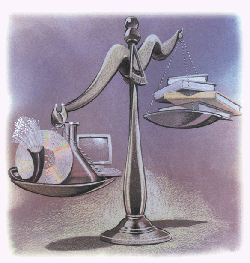Oct 1999 – Briefings
by David Brindley
Law
Science in the Courts

“Because evidence involving complex scientific, medical, and technical issues is becoming more prevalent in litigation,” said Mark Frankel of the AAAS, “judges increasingly need the assistance of independent experts who can help courts resolve these cases.”
Lawyers for both sides in court cases routinely bring expert witnesses into the courtroom to explain technical matters, but those experts are not always unbiased. Through the new program, judges will have access to neutral scientists and technologists. These court-appointed experts could educate judges and juries on technical issues, explain underlying scientific methodology or reasoning, comment on expert witness testimony and give their own assessments, or even help calculate the amount of money awarded. Impartial expert advice could prove especially useful in lengthy or complicated court cases such as the ongoing Microsoft antitrust trial.
Supreme Court justice Stephen Breyer endorsed the project when he addressed the AAAS last year: “I believe we must build legal foundations that are sound in science, as well as in law.”
Don’t expect engineering experts to pop up on The People’s Court, though; the new program is for federal judges only.
Patents
Whose Invention Is It Anyway?
Sometimes it doesn’t pay to be an inventor. In fact, sometimes inventors have to pay to use their own creations.
That’s increasingly the predicament for engineering professors and students who develop new technologies for campus-sponsored projects, but then want to use those technologies in their start-up companies. Universities generally claim rights to technologies developed on their campuses and then license those technologies to private companies. Those licensing agreements have become an important source of revenue for many universities. Stanford University, for example, received more than $62 million in royalties from nearly 300 licensed technologies in fiscal year 1998.
But what happens when the professor- or student-inventors want to buy a license from the university to develop their own technology? The same policy usually applies, and that can create problems for both parties.
Take Vanu Bose, who recently received his Ph.D. in electrical engineering from MIT. Bose has been seeking exclusive rights to license technology that he developed for his doctoral dissertation for use by his start-up company, Vanu, Inc. Since the work was done at the university, MIT owns the rights to the technology.
When Bose approached MIT’s Technology Licensing Office (TLO) for a license to use the software radio technology he invented, the TLO asked for $1.25 million in fees over the next eight years and up to 10 percent in royalties on services provided or products developed. In addition, MIT asked for 6 percent ownership in Vanu, Inc. Bose balked at the stiff terms and negotiations have continued for more than a year.
Though the licensing snafu snarled his plans, Bose’s greater concern, he says, “is that the TLO’s licensing policy places an unreasonable burden on any start-up.” According to Bose, MIT’s current policy requiring inventors who seek to develop their own technology to pay up-front puts an unreasonable burden on new companies. A better system, Bose believes, would allow the inventor to develop the technology and then pay licensing fees.
Universities, however, generally invest a lot of money and time in filing for patents on new technology, which they hope to eventually recoup. If they licensed the technology on a contingency basis, there would be no guarantee of future income.
For Bose, though, it turns out that the technology isn’t crucial for his business. “It would be nice to have,” he says, “but it’s not worth its weight in gold.” In this case, the inventor doesn’t pay—and nobody gains.
Environmental Boost
A new report from the National Science Foundation’s governing body recommends a billion-dollar increase in environmental research and education at the agency. The National Science Board’s recommendation, which would be phased in over five years, would nearly triple environmental spending at NSF to $1.6 billion annually.
General environmental research plays a necessary role in scientific advancements, says NSB Executive Secretary Penny Firth. “The report makes a clear, cogent, and compelling case for increased funding in this type of research,” Firth says.
NSF might have a tough time securing the additional funds from Congress, however. The House Appropriations Committee recently recommended a slight cut in NSF’s total budget for fiscal year 2000.
While it is too early to gauge what the interim report means for educators specifically, it does make clear that NSF should continue to encourage environmental efforts in the classroom while supporting informal educational approaches such as science centers. A final report, which will be issued after an undefined period of public review, will be used to guide NSF policy.
—Rahul Chadha
Category: Briefings